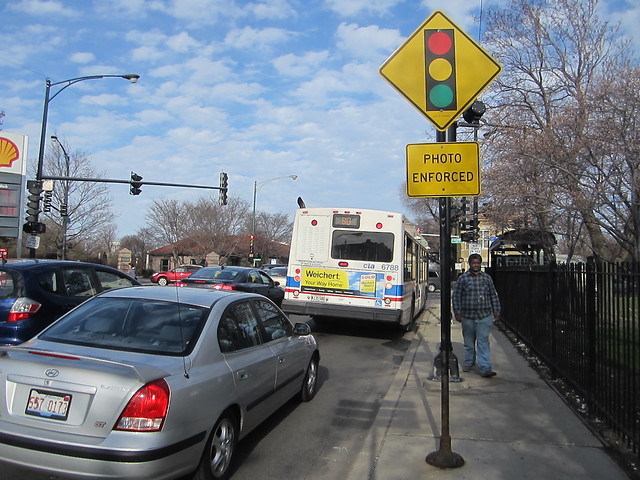Active Transportation Alliance director Ron Burke said the advocacy group approves of reforms to Chicago red light camera program that passed in City Council on Tuesday, but the city needs to keep its eyes on the prize of eliminating serious injuries and deaths from crashes. He called on Mayor Rahm Emanuel to formulate a comprehensive Vision Zero strategy for achieving this goal.
During the last election, Emanuel and many City Council members came under fire from opponents who pledged to abolish the automated enforcement program. In early March, Emanuel announced he would remove 50 red light cameras at 25 intersections that saw one or fewer right-angle crashes in 2013.
The mayor also promised to have pedestrian countdown signals installed at all of the city’s 174 red-light camera intersections by June 1. He pledged that community meetings would be held before red light cameras are installed, moved, or removed. At the time, several aldermen also proposed extending yellow signals from 3.0 seconds to 3.2 seconds, and requiring a council vote before installing new red light cameras.
The ordinance that passed codifies the requirement for the community meetings and pedestrian timers (all but nine of the red light cam intersections now have have these), and lowers the down payment that motorists with a large ticket debt must pay to avoid getting booted. The law also authorizes the Chicago Department of Transportation to appoint an outside academic team to do a full review of the effectiveness of the city’s red light camera program. The yellow light extension and City Council vote requirement did not make it into the final ordinance.
“As long as the city views these changes as a way to improve, rather than remove the cameras, that’s fine,” Burke said. “We’re all for community input on the camera locations.” He noted that local residents who walk, bike, and drive through neighborhood intersections on a regular basis have a good sense of which ones can best benefit from automated enforcement, although he wouldn’t support giving residents veto power over proposed cams locations.
Active Trans also is in favor of the pedestrian timers, even though they’re largely being installed for the benefit of drivers, which some national experts believe is an inappropriate use of the signals. “As long as the technology will benefit pedestrians, which it will, we’re all for it,” Burke said.
He’s most enthusiastic about a review of the program being conducted by impartial experts. “Back in March, we recommended that there should be a study of the program by an independent panel, or some such creature, and that’s what’s in this ordinance,” he said. He noted that there have been valid criticisms of some aspects of the program, such as questionable camera locations and the less-than-transparent way the city changed its standard to allow tickets to be issued after sub-3.0-second yellows.
“We said all along that the cams should be located where they’re going to do the most good to reduce crashes, irrespective of revenue generation,” Burke said. "That’s the right thing to do from a safety perspective, and that’s the right way to gain the public’s trust.”
Burke said it’s important to remember why we have the cameras in the first place: Chicago traffic crashes kill an average of 145 people a year, and significantly injure 21,000 more. While the city has an epidemic of dangerous driving, there aren’t enough police officers to enforce the laws, and the police already have their hands full addressing other crimes, so a well-run automated enforcement program can help fill the gap.
While the Chicago Pedestrian Plan, published in 2012, called for eliminating traffic fatalities within ten years, Burke said Emanuel still needs to put together a comprehensive Vision Zero strategy, similar to what Mayor Bill DeBlasio has done in New York. This led to DeBlasio reducing that city’s default speed limit to 25 mph.
Burke added that photo enforcement is just one piece of the puzzle for reaching that goal. Improvements to traffic engineering and street design, policy changes, and outreach and education will also be needed. “There are probably some additional strategies that need to be implemented, and more priority needs to be placed on certain strategies,” he said. “More funding may be necessary, and we’re going to need more interdepartmental cooperation. We’re hoping that a full-blown Vision Zero strategy is really going to flourish under Mayor Emanuels’ second term.”




